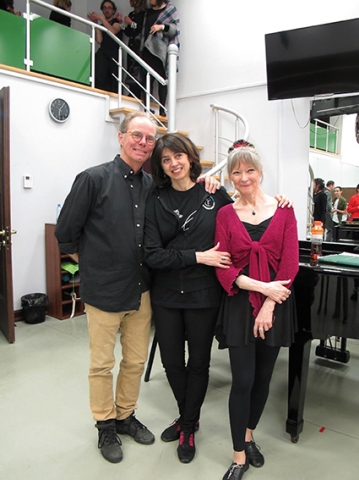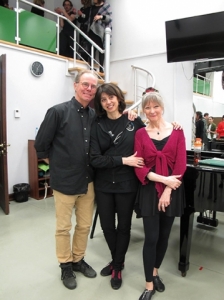Celebrated Danish Choreographers Teach Tbilisi to Dance Bournonville
The State Ballet of Georgia is preparing yet another surprise for theater goers and ballet enthusiasts. World-famous choreographers Frank Andersen and Dinna Bjørn from Denmark came to Tbilisi especially to bring back the unique Bournonville ballet together with the Georgian company, first staged in Georgia years ago at the initiative of Nino Ananniashvili, Artistic Director of the State Ballet.
The ballet ‘From Siberia to Moscow’ was made in 1876 by August Bournonville, a celebrated dancer and choreographer who directed the Royal Danish Ballet for nearly 50 years and established the Danish, so called Bournonville style, based on bravura dancing and expressive mime. Yet, the dance was preserved only through written form and went untouched for more than century until it was returned to life through the joint efforts of Andersen, Bjørn and Nino Ananiashvili.
Frank Andersen is a former Danish ballet dancer who was twice Artistic Director of the Royal Danish Ballet. He has also been an influential supporter of the Danish choreographer August Bournonville.
Dinna Bjørn is a Danish ballet dancer and choreographer specialized in dancing and directing the ballets of August Bournonville.
What is it about the Bournonville style that so fascinates dancers and audiences alike? The most distinctive feature is the illusion of lightness: the dancers seem to float: touching the floor briefly, only to set off in flight again. Dancing Bournonville is just as hard as dancing Petipa or Balanchine, they say, demanding completely different abilities from the dancer: genuine grace combined with the ability to understate even the largest steps, combined with the discretion of mime to ensure a heavy dramatic impact.
GEORGIA TODAY had the privilege to attend a rehearsal led by Frank and Dinna at the Tbilisi Opera studio. The masterclass conducted by the famous Danish ballet dancers was attended by the Friends of Georgian Ballet (a group of mixed expats and locals supporting Georgian ballet) as well as other invited guests.
“Both Frank Andersen and Dinna Bjørn are successors of ballet families,” Prima Ballerina Nino Ananiashvili tells GEORGIA TODAY. “Both teach and spread the Bournonville dancing style worldwide. The new performance we are preparing for the audience is really quite unique, since no-one has it in their repertoire. It is the very last ballet by August Bournonville, and for over 103 years this music went unheard. Fifteen years ago, when I came to this position [Artistic Director], I suggested that Frank revive this ballet after I saw a small part of Jockey Dance performed by male dancers. He told me that all the materials had been lost, but we kept pushing for it and struck some luck when Dinna found the materials written by Bournonville himself in her father’s archive. Her father, also a celebrated choreographer and head of the Royal Theater, after his death left a huge archive to his daughter in which she found the script of the dance dated 1876. All three of us were excited by this finding but reviving the dance from written materials required a lot of hard work. Dinna embarked on this serious mission and finally revived the dance documented on paper, together with Frank. The ballet was accompanied by Tchaikovsky’s overture, one that most musicians had not heard before.”
Ananiashvili explains that the plot of the ballet is complex, unveiling how two great minds, Bournonville and Marius Petipa, meet. Petipa tells Bournonville the story of Natalia and her father, who were in exile in Siberia. Among those in exile was Georgian nobleman Kipiani, who did everything to free Natalia and her father, and who eventually became a hero.
“The character of Kipiani is based on a real person, a student who was exiled to Siberia because of his revolutionary intentions together with other revolutionaries of different ethnicities,” Ananiashvili tells us. “And now we have managed to remake this ballet and return it to the stage of the Tbilisi Opera.”
The production is diverse, since it incorporates Georgian folk elements as well as dances of other nations.
“We are very happy to be back in Georgia; we have already been here several times,” Frank Andersen tells GEORGIA TODAY. “To be honest, before meeting Nina, I didn’t know that there was a Georgian Ballet Company, and it was like discovering a hidden gem. We immediately fell in love with the country, with the company and dancers. I met Nino for the first time in Montreal in 1998 and offered to work on the Bournonville style with her. After a year, she came to Denmark and stayed for three months, studying it. This is how our friendship began. Then, at her invitation, we came to Tbilisi and staged the ballet with the Georgian dancers. The special thing about teaching Bournonville to others is that you see how mature dancers, with whom you have previously worked, so quickly get into it from memory, and the younger dancers follow- so the knowledge is passed from one generation to the next,” he says, noting that the main thing that distinguishes Bournonville from other ballets is a “joy of life”. “This ballet tells the story of ordinary people, but at the same time it is very romantic,” he adds.
“It is amazing to come back here after 10 years and to see how the Company has developed since our first meeting,” Bjørn tells us. “Frank and I have traveled the world trying to pass on our knowledge about this tradition and it is nice to see that those dancers with whom we have worked come to master the Bournonville technique more easily, even if they are out of practice. And it is really rewarding to see how this tradition is living on here. The Bournonville dancing style generates joy. Even though it looks easy, it is extremely difficult to perform and to master the lightness characteristic to it,” the famous ballet dancer says.
August Bournonville gave Danish ballet an identity of which it is justly proud, and some of his prolific repertoire survives and delights to this day. In October, the Georgian audience will be fortunate enough to enjoy and experience this amazing dancing tradition at the Tbilisi Opera and Ballet State Theater.
By Lika Chigladze
Photo by Khatuna Gogichaishvili, The Messenger











